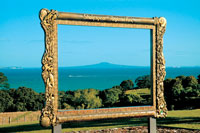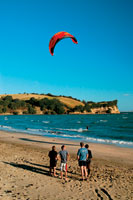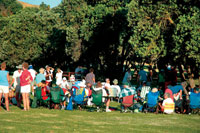The hidden gem on Auckland’s doorstep
 Louis Passe gets some rest and relaxation in before Christmas at Shakespear Park
Louis Passe gets some rest and relaxation in before Christmas at Shakespear Park
The Maui 4 berth that we picked up in Auckland was everything we needed for our pre-Christmas escape. We didn’t want to have to drive for hours and I wasn’t in the mood for a West Coast experience but, fortunately, the answer was close at hand. Auckland Regional Council owns and administers Shakespear Regional Park on the Whangaparaoa Peninsula. It was perfect for the weekend break we needed.
We drove up on the Friday night and arrived at the park just before dark. In the distance we could see the lights of Auckland shimmering across the water. Already the city felt a long way away. We were woken by the park ranger on Saturday morning who explained that the camping sites are not powered and that the charge was $6.00 per person per night. He showed us where we could settle in for the weekend and left us with a trail map.
Shakespear Regional Park sits at the end of the Whangaparaoa Peninsula. It offers safe swimming in sheltered bays surrounded by stands of regenerating native bush and rolling grassland. The park caters to a wide variety of water sports including snorkelling, rock fishing, diving, windsurfing and kite boarding. When the winds blow from the right quarter, hang gliders and  paragliders launch from the spectacular cliffs behind the beach at Te Haruhi Bay. Army Bay has an excellent launching ramp for small boats, jet skis and kayaks. The kayak paddle from Army Bay around the peninsula and back to Te Haruhi or Okoromai Bay takes a couple of hours, depending on the wind and tide conditions. Three separate walking trails through a variety of native bush and wetland habitats lead to a number of breathtaking vantage points. At this time of the year the pohutukawa were in full bloom and the bay was splashed with scarlet.
paragliders launch from the spectacular cliffs behind the beach at Te Haruhi Bay. Army Bay has an excellent launching ramp for small boats, jet skis and kayaks. The kayak paddle from Army Bay around the peninsula and back to Te Haruhi or Okoromai Bay takes a couple of hours, depending on the wind and tide conditions. Three separate walking trails through a variety of native bush and wetland habitats lead to a number of breathtaking vantage points. At this time of the year the pohutukawa were in full bloom and the bay was splashed with scarlet.
Early in the morning the park was almost deserted apart from two other motorhomes. After breakfast I went over and introduced myself to the McGlashans who had arrived down from Kerikeri a few days before with their Suzuki and a party of friends in tow. Equipped with two kayaks and all the luxuries of home they were heading south to the Central North Island lakes for a summer of trout fishing. The other motorhome was owned by the Harrisons who had sold their Auckland home six months before and spent the winter travelling around Northland, stopping for a week at one glorious beach after another. This was their first trip south of the Brynderwyns since they had left Auckland.
Archaeologists tell us that people have lived in this area for over 1000 years. Ngati Kahu was the last Maori tribe to occupy the peninsula. In 1883 they sold an 800-hectare block of land at the end of the peninsula to Mr. W. Shakespear. His family built a farmhouse overlooking Te Haruhi Bay in 1910, which has lately been transformed into a YMCA accommodation lodge for visitors. The farming activities of the early Europeans saw the area largely cleared of forest cover. These days, local volunteers and the ARC are heavily involved in a successful native replanting programme.
During WWII the NZ Army bought the end of the peninsula and fortified it as part of Auckland’s defences against the threat of a Japanese invasion. The defences are part of the Heritage Trail, which starts just a short walk from the car park. It is an interesting track, complete with interpretive signs and fascinating tales of the history of the local area. Apparently during WWII, explosive experts from the Defence Department were trialling a secret weapon here that was supposed to explode with sufficient force to create a localised tsunami. The tsunami bomb was designed to inundate the smaller Pacific Islands that were held by the Japanese. The device was never used in combat, but it was not a complete failure. In one practice detonation, the elderly Mrs Shakespear was blown off the sofa in her lounge by the blast force!
A splendid wetland, many giant puriri trees with woodpigeons, tui, kakariki and bellbirds and a small waterfall added to the enjoyment of the half hour walk. Although less than an hour’s drive from Auckland the track created an amazing juxtaposition of images. One minute we were deep in a world of birds, epiphytes and tree ferns and the next the distant Skytower and the suburban development at Gulf Harbour were poking their noses into the isolation. The view from the Lookout was a truly spectacular 360º panorama of the Hauraki Gulf and the cityscape of Auckland.
By the time we returned to the camper from our walk, the first of the day’s many Stagecoach buses was disgorging its day-trippers. Within the space of a few hours, hundreds of people arrived with picnic blankets and hampers and a colourful carnival atmosphere engulfed the bay. We spent the rest of the day swimming and lazing on the beach in the summer sun. Towards dusk we took our torches and walked back to the little gully with the waterfall. As darkness fell we watched in silence as a myriad of glow-worms created an enchanting display unperturbed by the lights of Auckland city reflected in the sky. Once more we were alone in the silence.
 We slept late the next morning and weren’t all that excited about being inundated by large numbers of people again, so after morning tea we headed for the relative isolation of the bush tracks again. The Tiritiri Track starts at Te Haruhi Bay and it takes about 2 hours to traverse. Although it is only five kilometres in length it is steep in places. It passes the remains of an old Maori village and continues above the cliffs around to Pink Beach and an unobstructed view of Tiritiri Matangi Island, just a couple of kilometres away across the Tiri Channel. Tiritiri Matangi is a world-renowned bird sanctuary and can be accessed via a short ferryboat ride from Gulf Harbour. It is a wonderfully educational experience for Aucklanders and overseas tourists alike. They say that the endangered Takahe is so tame that they will try to unpick your shoelaces if you let them. To be able to experience the songs of bellbirds and saddlebacks is a rare opportunity, especially so close to Auckland. We promised ourselves a trip to the island bird sanctuary next time.
We slept late the next morning and weren’t all that excited about being inundated by large numbers of people again, so after morning tea we headed for the relative isolation of the bush tracks again. The Tiritiri Track starts at Te Haruhi Bay and it takes about 2 hours to traverse. Although it is only five kilometres in length it is steep in places. It passes the remains of an old Maori village and continues above the cliffs around to Pink Beach and an unobstructed view of Tiritiri Matangi Island, just a couple of kilometres away across the Tiri Channel. Tiritiri Matangi is a world-renowned bird sanctuary and can be accessed via a short ferryboat ride from Gulf Harbour. It is a wonderfully educational experience for Aucklanders and overseas tourists alike. They say that the endangered Takahe is so tame that they will try to unpick your shoelaces if you let them. To be able to experience the songs of bellbirds and saddlebacks is a rare opportunity, especially so close to Auckland. We promised ourselves a trip to the island bird sanctuary next time.
By late Sunday afternoon the wind had picked up and a hoard of windsurfers and kite boarders arrived. Their bright sails and kites created a colourful panorama as they rode with the wind and became airborne on the choppy waves. As the days picnickers began to depart the clean up crew moved in. Officially, the ARC runs a rubbish free park policy. Rubbish bins are not provided and people are requested to take their rubbish home and recycle it. By the time sunset came the park was spotless, deserted and beautiful once again. We walked along Okoromai beach, watching the lights of the city coming on as the shore birds fed and the sky became a blaze of colour. It made me wonder how many Aucklanders are aware of the wonderful gem they have right on their doorstep.
SHAKESPEAR PARK FACT FILE
For site bookings phone (09) 366 2000
The ARC runs Volunteer Days at Shakespear Park every Tuesday from 8.30am especially for folks that would like to meet the Rangers and help out with park projects like tree planting. Volunteers phone (09) 3662000
The Kawau Cat operates a boat trip to Tiritiri Matangi Island, which leaves from Gulf Harbour at 9.40am on Saturday and Sunday every weekend. The boat leaves Tiritiri Matangi at 4pm. Cost for adults; $26. Children cost $14 and family passes cost $66.








Join the Discussion
Type out your comment here:
You must be logged in to post a comment.